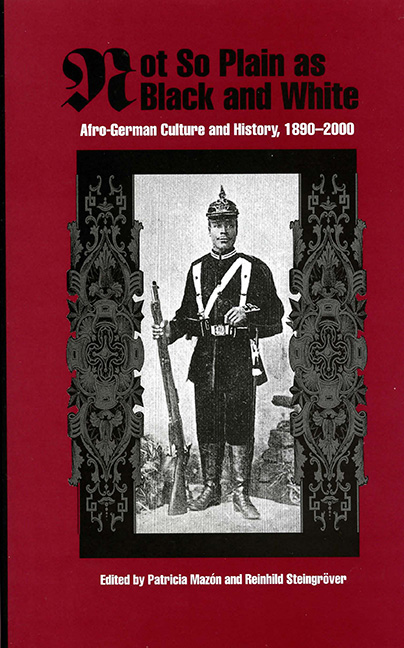Book contents
- Frontmatter
- Contents
- Foreword
- Introduction
- Part I Afro-Germans in Historical Perspective
- Part II Cultural Representations and Self-Representations of Afro-Germans
- 4 Louis Brody and the Black Presence in German Film Before 1945
- 5 Narrating “Race” in 1950s’ West Germany: The Phenomenon of the Toxi Films
- 6 Will Everything Be Fine? Anti-Racist Practice in Recent German Cinema
- 7 Writing Diasporic Identity: Afro-German Literature since 1985
- 8 The Souls of Black Volk: Contradiction? Oxymoron?
- Selected Bibliography
- Notes on Contributors
- Name Index
8 - The Souls of Black Volk: Contradiction? Oxymoron?
from Part II - Cultural Representations and Self-Representations of Afro-Germans
Published online by Cambridge University Press: 11 May 2017
- Frontmatter
- Contents
- Foreword
- Introduction
- Part I Afro-Germans in Historical Perspective
- Part II Cultural Representations and Self-Representations of Afro-Germans
- 4 Louis Brody and the Black Presence in German Film Before 1945
- 5 Narrating “Race” in 1950s’ West Germany: The Phenomenon of the Toxi Films
- 6 Will Everything Be Fine? Anti-Racist Practice in Recent German Cinema
- 7 Writing Diasporic Identity: Afro-German Literature since 1985
- 8 The Souls of Black Volk: Contradiction? Oxymoron?
- Selected Bibliography
- Notes on Contributors
- Name Index
Summary
“The term Afro-German is still new in West Germany. It came to life when a few women of African-German descent met in 1984 with the Afro-American writer Audre Lorde and decided to define themselves instead of constantly being defined by others.” These opening statements by May Ayim (née Opitz) at the 1994 PANAFEST arts festival in Ghana would introduce to a welcoming Pan-African audience the “new kids on the block” of the African diaspora: Afro-Germans. The coincidence— maybe—of place, time, and identity, of Ayim's talk is useful for contextualizing Afro-German consciousness within a framework of the African diaspora. Indeed, this would be the last invited talk on the subject of Afro-German identity that activist/writer Ayim would give; the inspiring spokeswoman for Afro-German consciousness would take her own life the following year, at the age of thirty-six. The place, Ghana, is the adopted homeland and final resting place of W. E. B. DuBois, the “Father of PanAfricanism”; the time, 1994, is one hundred years after DuBois's student sojourn in Ayim's native country and final resting place, Germany. The fact that the stimulating, international city of Berlin was the place where both DuBois and Ayim sojourned and came into political maturity may not be a coincidence. For DuBois the attraction was the distinguished faculty of the Friedrich Wilhelm University of Berlin (now the Humboldt University); for Ayim, it was the cosmopolitan character of the city, which tolerated racial, ethnic, and cultural diversity more than other places in her country. But what is an intriguing coincidence is the fact of DuBois's residence in 1892–94 in the Oranienburg Strasse in the district of Kreuzberg, a few doors away on the same street as the current offices of the Initiative Schwarze Deutsche(Initiative of Black Germans), or ISD, of which Ayim was a co-founder in 1984. Like Ayim a century later, DuBois was a precursor of African diaspora individuals whose intellectual and human-rights careers would bring them to Germany, in general, and Berlin, in particular. Since any legitimate consideration of the relationship of people of the African world to the European world must ultimately refer to the work of W. E .B. DuBois, these coincidences—maybe—between Ayim and DuBois enhance our discussion of Afro-Germans.
- Type
- Chapter
- Information
- Not So Plain as Black and WhiteAfro-German Culture and History, 1890–2000, pp. 209 - 232Publisher: Boydell & BrewerPrint publication year: 2005

